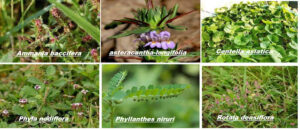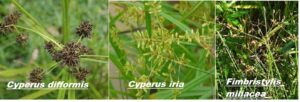Weed Management in Rice (Oryza sativa)
Weed Management in Rice (Oryza sativa) ;
Introduction;
Weed is an unwanted plant that grows with the main crop. weeds compete with the main plant for nutrients, water, space, sunlight, etc and ultimately It results in a growth hindrance of the main crop plants.
As per an estimation, the total economic losses due to rice weeds in India is around 11 Billion USD considering the 18 states and 10 major crops, out of which the economic losses due to weed infestation in direct-seeded rice are about 21% and in the case of transplanted rice it is about 14%
Why Weed Control is important?
1) weeds cause yield losses because they directly compete with main the main plant for nutrients, Sunlight, and water
2) Weeds enhance the production cost eg; Increase cost of labor and farm inputs
3) Weeds act as hosts for several insects, pathogens, and rodents like rats
4) Drastically reduces the quality and price of the grain.
5) Weeds puts the hindrance in free water flow through the irrigation channel in the field
Important weeds of Rice Crop ;
Direct-seeded rice has more weeds problems in comparison to transplanted rice because the soil is directly exposed to the atmosphere whereas in transplanted rice weeds emerge when the soil is exposed to the atmosphere as submergence is not possible continuously. Under such conditions, yield may be reduced from 20% to 40%.
The most commonly found weeds in transplanted rice are given below:
|
Grasses |
Broad Leaves |
Sedges |
|
Echinochloa colona |
Ammania baccifera |
Cyperus difformis |
|
Echinochloa crus-galli |
Asteracantha longifolia |
Cyperus iria |
|
Chloris barbata |
Centella asiatica |
Fimbristylis milliacea |
|
Panicum sp |
Commelina benghalensis |
|
|
Cynodon dactylon |
Cyanotis axillaris |
|
|
|
Eclipta prostrata |
|
|
|
Phyla nodiflora |
|
|
|
Phyllanthes niruri |
|
|
|
Rotala densiflora |
|
|
|
Ruellia tuberose |
|
|
|
Sonchus oleraceus |
|
|
|
Sphaeranthus indicus |
|
A) Grassy weeds of Rice ;
B) Broad Leaves weeds of Rice;
Weeds Control Metods in Rice;
a) At the time of land preparation;
1) Weed control time field preparation is very essential to reduce the weed pressure in the rice field.
2) The field preparation must be started 3 to 4 weeks prior to planting.
3) A deep plowing destroys all the weeds and crop residue of the previous crop.
4) weeds should be allowed to freely grow before the scheduled cultivation.
5) In the case of wet seeded rice plough and harrow, the field 2 to 3 times depending upon the weeds population and allow the weed to emerge for 15 days after 15 days give light tillage
6) whereas in dry seeded rice after one to two weeks of weed emergence destroy the weeds by using a non-selective herbicide like glyphosate, paraquat, glufosinate, or control weeds by manual/mechanical weeding
b) Weed Control in the Nursery;
1) The land for the nursery should be prepared two to three weeks prior to seeding.
2)The soil of the nursery bed should be clean and free from all kinds of weeds.
3)Apply any one of the pre-emergence herbicides two to three days after the sowing – Butachlor @ 2lit/ha or Pendimethalin 2.5 l/ha (or) Anilophos 1.25 l/ha.
4)There should be no drainage of water It will help in controlling the weeds
c) Weed Control in the Main Field;
1)The surface of the soil should not be dry after the transplanting so that the performance of pre-emergence herbicide may not get deteriorated
2)There should be a 5-7cm water depth in the field till 7-10 days before the harvest it will check the weed germination.
3) Rotatory/ Push weeder can be used to control the weeds at the 3-4 leaf stages after that fill the field with water one day later so that uprooted weeds could not get recovered.
4) Hand weeding is required till the canopy closes
5) Pre-emergence Herbicides;
a) Apply the pre-emergence herbicides 2 to 3 days after transplanting /Date of Sowing.
b) For the transplanted rice ;
- Apply Pyrazosulfuron ethyl 10 % WP @ 150 g /Ha three days after transplanting or
- Apply Butachlor @ 1.25kg/ha or
- Anilophos @ 0.4kg/ha one to three days after transplanting or Apply pretilachor @ 1.0 kg a.i./ ha one to three days after transplanting.
b) For Wet Seeded Rice ;
- Apply pretilachlor @ 300 gms/ha+ fenclorim @ 150 gms/ha.one to three days after sowing.
c) For Dry Seeded Rice ;
- Apply Oxadiazon @ 1 kg ai/ha or
- Apply Pendimethalin@1kg ai/ha, or
- Apply Oxadiargyl 80% WP .@ 100 g.a.i./ha
6) Post Emergence Herbicides; Apply any of the following given herbicides at 3 to 4-leaf stage
-
Apply early post-emergence Bisparybacsodium @ 50 gms a.i./ha or 250 ml/gms per ha It has the ability to control the broad-spectrum weed, control grasses, broad leaves, and annual sedges. It also has good control of Echinochloa species but this product shows weakness to control grasses other than Echinochloa species, including Leptochloa Chinensis, Dactyloctenium Egyptian, Eleusine indica, Eragrostis species. or
- Apply Fenoxaprop 9.3EC@ 250 ml/ha + Safener @0,40 kg/ha, or
- Fenoxaprop 9.3EC@250 ml/ha + ethoxysulfuron 15 WG@ 100 gms/acre, it has good control of annual grassy weeds, safe on rice at an early stage. or
- Metsulfuron + chlorimuron @ 20gms/ha it is effective on broad leaves and annual sedges.or
- Apply Azimsulfurom @35-70 gm/ha It is a Broad-spectrum control of grasses, broad leaves, and sedges. Good control of sedges, including Cyperus rotundus. or
- Apply Penoxsulam 22.5 gms ai/ha or @ 93.5 ml/ha it is a broad-spectrum weed control of grasses, broadleaves, and annual sedges.
Precautions for Herbicidal spray;
1) All the spraying equipment like spray tanks, booms, and nozzles should be well-cleaned after every use.
2) Never mix herbicides together unless recommended
3) Apply herbicides as per the recommended dose
2) Never mix herbicides together unless recommended
3) Apply herbicides as per the recommended dose
4) Avoid spraying on windy and rainy days
5) Always use a flat pan or Even spray nozzle
6) Always wear proper protective equipment. Like gloves, breathing masks, goggles, and protective clothing) while spraying.
6) Always wear proper protective equipment. Like gloves, breathing masks, goggles, and protective clothing) while spraying.
7) Store herbicides in properly labeled containers and should be far away from the reach of Children.








I needed to thank you for this wonderful read!! I absolutely loved every bit of it. I have you saved as a favorite to check out new things you postÖ
Good post. I learn something totally new and challenging on blogs I stumbleupon on a daily basis. Its always useful to read content from other authors and practice something from their websites.
A motivating discussion is definitely worth comment. Theres no doubt that that you need to write more on this subject matter, it may not be a taboo matter but generally folks dont discuss such subjects. To the next! Kind regards!!